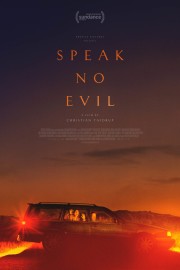Speak No Evil
If you listened to the embedded podcast “review” and interview with “Speak No Evil” director Christian Tafdrup when the movie played Sundance, you’ll know that I was struggling with how to articulate how I felt about the film. Part of that is because, if you reveal even the hint of things happening in this film, that almost reveals too much, but also, I don’t know that I’ve ever had quite as visceral and uncomfortable a reaction to a horror movie as I did with this one. Now that it is hitting Shudder, and more people are able to watch it, it’s time to give this film a thorough once over.
A big chunk of my initial reaction to “Speak No Evil” is how Tafdrup and his co-writer brother, Mads, give the main characters so many outs to just remove themselves from the situation, and they don’t take them, or worse, have to just grin and ride it out, especially when Agnes (Liva Forsberg), their daughter, seems to have lost something precious to her. Characters in horror have a long, proud tradition of being brain dead for plot purposes, but when you examine the characters of Bjorn (Morten Burian) and Louise (Sidsel Siem Koch)- a Danish couple- and how they behave throughout the film, it makes sense that they don’t. There’s a sense of politeness that they operate with during the movie that is innate to them, even during moments of discomfort. So when they finally confront Patrick (Fedja van Huêt) and Karin (Karina Smulders), the Dutch family they met over a summer holiday, about why they felt the need to leave their weekend stay in the middle of the night, it’s awkward, and even with their misgivings, they agree to give it one more day, because Patrick- a very smooth communicator- promises a great day.
The way in which Tafdrup uses the languages these character’s speak is fascinating, and a big part of why this film just rattles you. English is a common language for all the characters, but we do see both families slip into their native languages when talking to one another- the catch is, only the Danish family is subtitled; the Dutch family is not. This is representative of one of the primary themes of the film- how lack of communication can make awkward situations worse- but it isn’t just about how Bjorn and Louise do not properly express their concerns to Patrick and Karin; if either of them shared what they saw about this couple with one another, different choices could have been made. Why doesn’t Louise share what she saw? Why doesn’t Bjorn share what he’s seen? Any rational people would have, but that’s not how people in horror movies typically work, and how can either parent be rational after seeing what they did? I’d want to leave, no questions asked, as well.
One of the most remarkable things about “Speak No Evil” is how quickly Tafdrup calls his shot in terms of the atmosphere he is setting, and how he maintains it for 97 minutes. Part of that is the score by Sune Kølster, which channels the music from “The Shining,” and tone from Howard Shore’s work with Cronenberg. The first thing we see is a car travelling down a dark road, and the score is setting the tone of ominous dread immediately; it turns out, it’s just Patrick, Karin and their son Abel (Marius Damslev) arriving at the resort where they meet Bjorn and Louise. Horror is often used as a way of commenting on reality, sometimes in a personal way- it’s natural to meet people, and connect with others, that you may never see again while on vacation; taking that in the direction he does is playing off of a very primal fear of strangers submerging themselves into your lives. This movie should make you uncomfortable.
There are so many red flags that come up for us. The isolated playground Patrick and Karin take them to. Patrick’s insistence that Louise eat meat even though she’s said many times before that she’s a vegetarian. Getting Bjorn and Louise to pay for dinner. Louise in the shower. Her and Bjorn making love. The ways in which Tafdrup just continually plays with our emotional barometer in this film is the sign of a gifted filmmaker, who will get us to buy anything, even the unlikely scenario that anyone would stay in this situation as long as they do. The last 20-25 minutes of “Speak No Evil” is as anxiety-inducing a stretch of film as anyone’s put on-screen in a while. At that point, however, the damage is done. “Speak No Evil” spoke to me in a way few horror films have, and watching it over again (I’m up to three viewings) is a lesson in how, sometimes, the only thing you can do during an uncomfortable situation is speak up.










